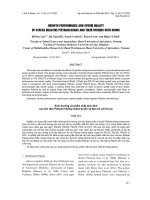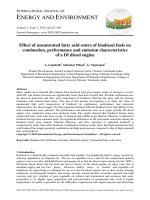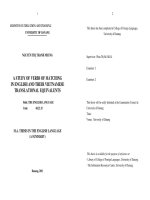Kortmans literary periods and their characteristics
Bạn đang xem bản rút gọn của tài liệu. Xem và tải ngay bản đầy đủ của tài liệu tại đây (3.82 MB, 32 trang )
American Literary Periods
and Their Characteristics
Puritan/Colonial
1650-1750
Historical Context
• A person’s fate is
determined by God
(predestination)
• All people are
corrupt and must be
saved by Christ
(Original Sin)
• Covenant of Grace
and Covenant of
Works debate
Puritan/Colonial
1650-1750
Genre/Style
• Sermons,
diaries,
personal
narratives
• Written in plain
style
Puritan/Colonial
1650-1750
Effect/Aspects
• Instructive
• Reinforces authority of the Bible and
church
Puritan/Colonial
1650-1750
Examples
•
•
•
•
Bradford's Of Plymouth
Plantation
Rowlandson's "A Narrative
of the Captivity”
Edward's "Sinners in the
Hands of an Angry God”
Though not written during
Puritan times, The Crucible
& The Scarlet Letter depict
life during the time when
Puritan theocracy prevailed.
Revolutionary/Age of Reason
1750-1800
Historical Context
• Tells readers how
to interpret what
they are reading
• Meant to
encourage
Revolutionary
War support
• Instructive in
values
Revolutionary/Age of Reason
1750-1800
Genre/Style
• Political
pamphlets
• Travel writing
• Highly ornate
style
• Persuasive
writing
Revolutionary/Age of Reason
1750-1800
Effect/Aspects
• Patriotism grows,
Instills pride
• Creates common
agreement about
issues
• National mission and
the American
character
Revolutionary/Age of Reason
1750-1800
Examples
• Writings of Thomas Jefferson,
Thomas Paine- “Common
Sense”
• Benjamin Franklin's Poor
Richard's Almanac and "The
Autobiography"
Romanticism
1800-1860
Historical Context
• Expansion of
magazines,
newspapers, and
book publishing
• Slavery debates
• Industrial revolution
brings ideas that the
"old ways" of doing
things are now
irrelevant
Romanticism
1800-1860
Genre/Style
•
•
•
•
•
Character sketches
Frontier exploits
Slave narratives
Poetry
Short stories
Romanticism
1800-1860
Effects/Aspects
• Value feeling and intuition
over reasoning
• Journey away from
corruption of civilization
and limits of rational
thought toward the
integrity of nature and
freedom of the
imagination
• Helped instill proper
gender behavior for men
and women
• Allowed people to reimagine the American
past
Romanticism
1800-1860
Examples
• Washington Irving's
"Rip Van Winkle
• William Cullen Bryant's
"Thanatopsis"
• Dunbar's "We Wear the
Mask"
• Poems of Emily
Dickinson
American Renaissance/Transcendentalism
1840-1860
Historical Context
• Transcendentalists:
*True reality is spiritual
– *Comes from18th
century philosopher
Immanuel Kant
• Idealists
• Self-reliance &
individualism
• * Emerson & Thoreau
• Seeking true beauty and
understanding in life and
in nature
American Renaissance/Transcendentalism
1840-1860
Genre/Style
•
•
•
•
Poetry
Short Stories
Novels
*Hold readers’ attention
through dread of a series
of terrible possibilities
• *Feature landscapes of
dark forests, extreme
vegetation, concealed
ruins with horrific rooms,
depressed characters
Realism
1855-Civil War & Post War period
Historical Context
• Civil War brings demand for a "truer" type of
literature that does not idealize people or places
• Battlefield Photography
Realism
1855-Civil War & Post War period
Genre/Style
• Novels and short
stories
• Objective narrator
• Does not tell reader
how to interpret story
• Dialogue includes
voices from around
the country
Realism
1855-Civil War & Post War period
Effect/Aspects
• Social realism: aims
to change a specific
social problem
• Aesthetic realism: art
that insists on
detailing the world as
one sees it
Realism
1855-Civil War & Post War period
Examples
• Writings of Mark Twain,
Ambrose Bierce, Stephen
Crane The Narrative of
the Life of Frederick
Douglass
• The Adventures of
Huckleberry Finn (some
say 1st modern novel)
• Regional works like: The
Awakening. Ethan Frome,
and My Antonia (some
say modern)
•Regionalism
was a literary movement in which
authors would write a story about specific
geographical areas.
•Writers in this time not only tried to show the
region they wrote about to their readers, but they
also made an attempt at a sophisticated
sociological or anthropological treatment of the
culture of the region.
•By writing about regions, the authors explore the
culture of that area including its•Languages
•Customs
•Beliefs
•history
Authors of Regionalism
Willa Cather
William Faulkner
Kate Chopin
Frank Norris
Trend rather than a movement; never formalized nor dominated by the influence
of a single writer
A more extreme, intensified version of realism
Shows more unpleasant, ugly, shocking aspects of life
Objective picture of reality viewed with scientific detachment
Determinism – man’s life is dominated by the forces he cannot control:
biological instincts, social environment
No free will, no place for moral judgment
Pessimism
Disillusionment with the dream of success; collapse of the predominantly
agrarian myth
Struggle of an individual to adopt to the environment
Society as something stable, its predictability allowed one to present a
universal human situation through accurate representation of particulars
Faith in society and art
The Moderns
1900-1950
Historical Context
• Writers reflect the ideas
of Darwin (survival of the
fittest), Karl Marx (how
money and class
structure control a
nation), and Sigmund
Freud (the power of the
subconscious)
• Overwhelming
technological changes of
the 20th Century
• Rise of the youth culture
• WWI and WWII
The Moderns
1900-1950
Genre/Style
• Novels Plays
• Poetry (a great
resurgence after deaths
of Whitman & Dickinson)
• Highly experimental as
writers seek a unique
style
• Use of interior monologue
& stream of
consciousness
The Moderns
1900-1950
Effect/Aspect
• In Pursuit of the American
Dream—
• Admiration for America as
land of Eden
• Optimism
• Importance of the
Individual
•
Fitzgerald's The Great Gatsby
•
Poetry of Jeffers, Williams,
Cummings, Frost, Eliot,
Sandburg, Pound, Robinson,
Stevens
•
Rand's Anthem
•
Short stories and novels of
Steinbeck, Hemingway,
Thurber, Welty, and Faulkner
•
Hansberry's A Raisin in the
Sun & Wright's Native Son (an
outgrowth of Harlem
Renaissance-- see below)
•
Miller's The Death of a
Salesman (some consider
Postmodern)
The Moderns
1900-1950
Examples









